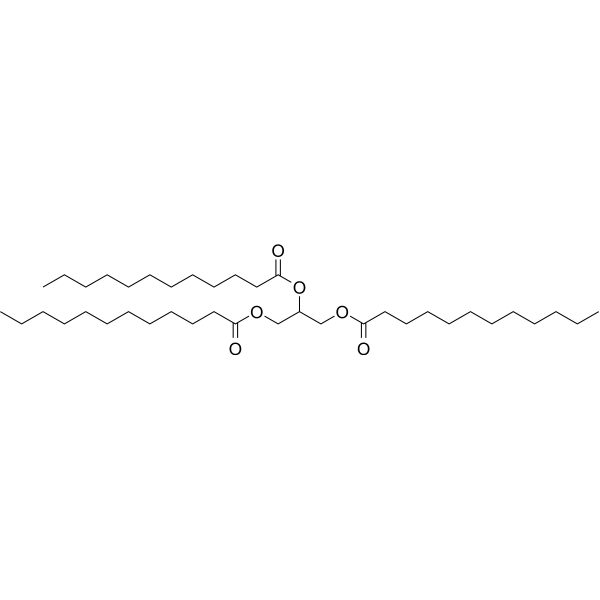
Trilaurin
CAS No. 538-24-9
Trilaurin( Glyceryl tridodecanoate | NSC 4061 | 1,2,3-Tridodecanoylglycerol | Tridodecanoin | Trilauroylglycerol | Glycerol trilaurate, Glyceryl trilaurate )
Catalog No. M27155 CAS No. 538-24-9
Trilaurin is a triacylglycerol found in dietary fats. Trilaurin can be used in cosmetic products as a thickening agent.
Purity : >98% (HPLC)
 COA
COA
 Datasheet
Datasheet
 HNMR
HNMR
 HPLC
HPLC
 MSDS
MSDS
 Handing Instructions
Handing Instructions
| Size | Price / USD | Stock | Quantity |
| 500MG | 38 | In Stock |


|
| 1G | 52 | In Stock |


|
Biological Information
-
Product NameTrilaurin
-
NoteResearch use only, not for human use.
-
Brief DescriptionTrilaurin is a triacylglycerol found in dietary fats. Trilaurin can be used in cosmetic products as a thickening agent.
-
DescriptionTrilaurin is a triacylglycerol found in dietary fats. Trilaurin can be used in cosmetic products as a thickening agent.
-
In Vitro——
-
In Vivo——
-
SynonymsGlyceryl tridodecanoate | NSC 4061 | 1,2,3-Tridodecanoylglycerol | Tridodecanoin | Trilauroylglycerol | Glycerol trilaurate, Glyceryl trilaurate
-
PathwayOthers
-
TargetOther Targets
-
RecptorER| LXR
-
Research Area——
-
Indication——
Chemical Information
-
CAS Number538-24-9
-
Formula Weight639.015
-
Molecular FormulaC39H74O6
-
Purity>98% (HPLC)
-
SolubilityIn Vitro:?DMSO : 4 mg/mL (6.26 mM)
-
SMILESCCCCCCCCCCCC(=O)OCC(COC(=O)CCCCCCCCCCC)OC(=O)CCCCCCCCCCC
-
Chemical Name——
Shipping & Storage Information
-
Storage(-20℃)
-
ShippingWith Ice Pack
-
Stability≥ 2 years
Reference
1.Raza S, et al. The cholesterol metabolite 27-hydroxycholesterol stimulates cell proliferation via ERβ in prostate cancer cells. Cancer Cell Int. 2017 May 11;17:52.
molnova catalog



related products
-
Histone H3 (1 - 25),...
Histone H3 (1 - 25),amide
-
trans-Urocanic Acid
trans-Urocanic Acid ((E)-Urocanic acid), a compound predominantly distributed in the hippocampus and prefrontal cortex, is an isomer of cis-UCA, an epidermal UV-protectant, which enhances the stability of tenofovir eplerenomide in long-acting HIV applications.
-
Gibbs reagent
Gibbs reagent is a versatile visualization reagent for thin-layer chromatography.



 Cart
Cart
 sales@molnova.com
sales@molnova.com


